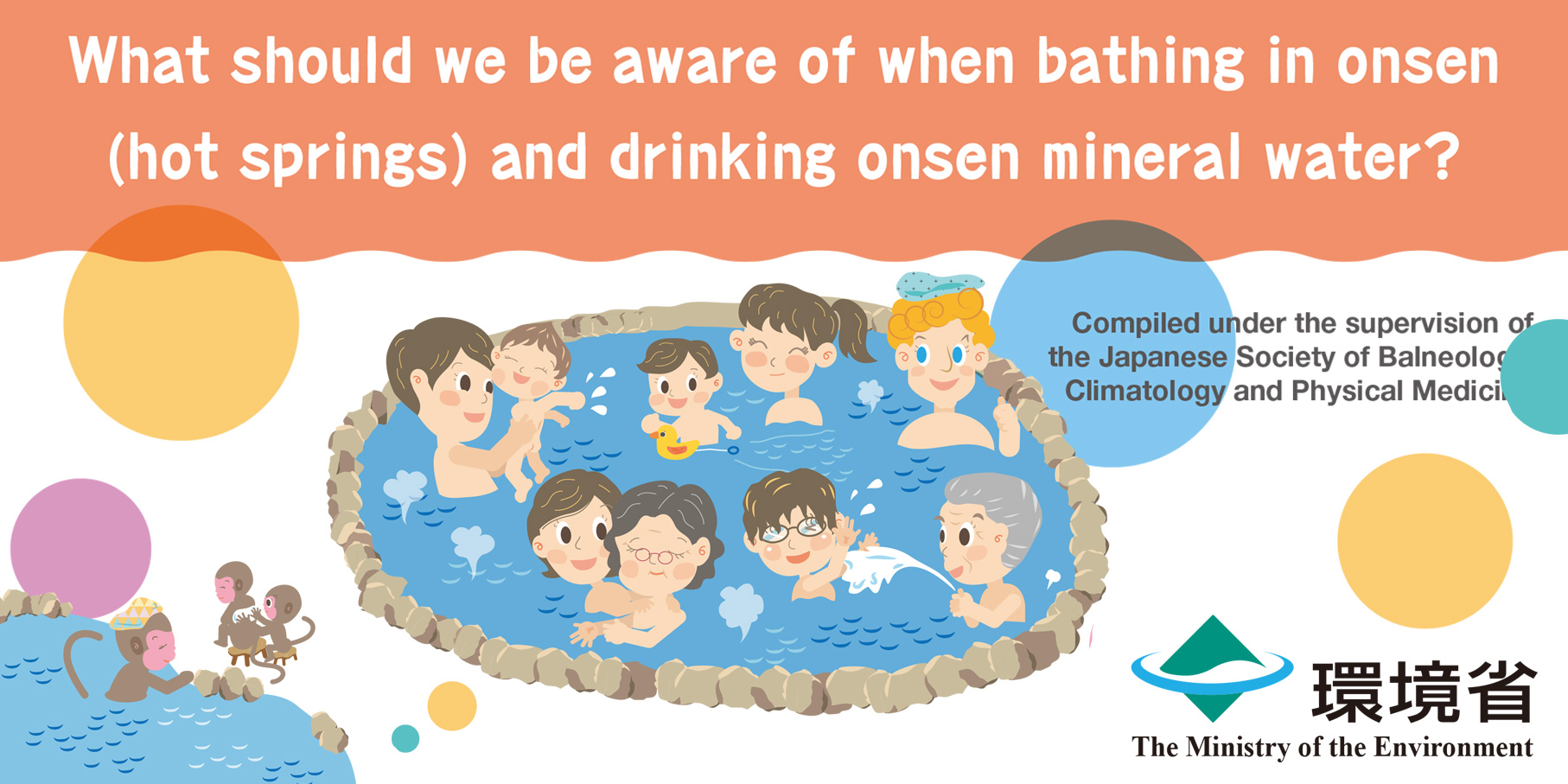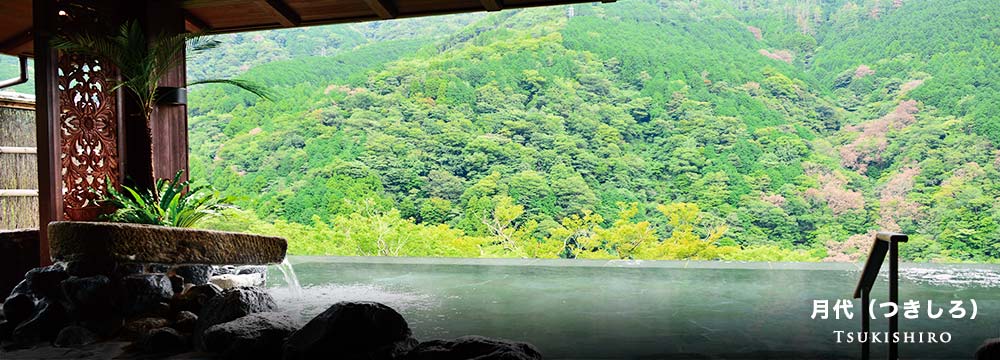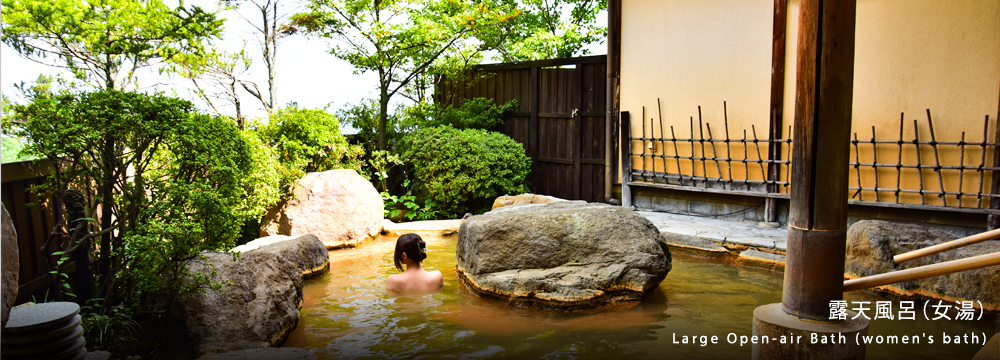
CHIGIRA JINSENTEI
| Calcium, Sodium – Sulfate / Hydrogen carbonate / Chloride springs | pH |
|
| カルシウム・ナトリウム-硫酸塩・炭酸水素塩・塩化物泉 | ||
| (Hypotonic, Neutral, Hot spring) | ||
| Old springs name:Bicarbonate earth springs―Gypsum spring | ||
Ideal for people like this
- Who want to test the skin beautifying effect
- Who have dry skin
- Who want to treat cuts quickly
- Who are feeling stressed
- Who have sensitivity to cold
- Who want to feel refreshed after bathing
- Address
- 45 Ikaho, Ikaho-machi, Shibukawa-shi, Gunma 377-0102, JAPAN
- Phone
- +81-(0)279-72-3355

Official Website

Travel Journal
Hot Spring Power Chart (5-point scale)
Hydrogen Ion Concentration (pH)

- Comment
- Neutral is a gentle hot spring with low-irritation
Hot spring Specification
※This is an easy-to-understand expression based on the indications for each type of spring in the "Standard Methods of Analysis for Mineral Springs" revised in July 2014 by the Ministry of the Environment.
| ①Mental recovery | ②Insomnia | ③Promote blood circulation | ④Sensitivity to cold | ⑤Dry skin |
| ⑥Cuts | ⑦Skin diseases | ⑧Hypertension (mild) | ⑨Heartburn (drinking) | ⑩Gastrointestinal disorders (drinking) |
| ⑪Constipation (drinking) | ⑫Lifestyle-related disease | ⑬Diabetes | ⑭Gout | ⑮Countermeasures against metabolic syndrome |
| ⑯Biliary system anxiety | ⑰Anaemia | ⑱Arthritis rheumatica | ⑲Spinal pain | ⑳Improved immunity |
| ㉑Muscle pain・Neuralgia | ㉒Mild asthma | ㉓Hemorrhoidal pain | ㉔Recovery from an illness | ㉕Recovery from fatigue |
- ※Note①・・・Indications for each spring include autonomic instability and depression.(Simple springs・Chloride springs・Sulfate springs・Carbon dioxide springs)
- ※Note③・・・Indications for each spring include peripheral circulatory disturbance(Chloride springs・Carbonate springs・Carbon dioxide springs・Hydrogen sulfide type Sulfur spring)
- ※Note④・・・Indications for each spring include sensitivity to cold(Chloride springs・Carbonate springs・Sulfur springs・Carbon dioxide springs)and Iron containing springs
- ※Note⑦・・・Indications for each spring include xeroderma, atopic dermatitis, plaque psoriasis, epidermoid suppuration, chronic eczema(Chloride springs・Carbonate springs・Sulfate spring・Acid springs・Sulfur springs)
- ※Note⑨・・・Indications for drinking each spring include reflux esophagitis(Carbonate springs)
- ※Note⑩・・・Indications for drinking each spring include atrophic gastritis, gastroduodenal ulcerations(Chloride springs・Carbonate springs)
- ※Note⑪・・・For drinking, Chloride springs and Sulfate spring
- ※Note⑫・・・Indications for each spring include hypercholesterolemia, diabetes, gout(for bathing, Acid springs・Radioactive springs/for drinking, Carbonate springs・Iodine containing springs・Sulfur springs)
- ※Note⑮・・・Indications for drinking each spring include hypercholesterolemia(Sulfate spring・Iodine containing springs・Sulfur springs)
- ※Note⑱⑲・・・Indications for each spring include rheumatoid arthritis, ankylosing spondylitis(Radioactive springs)
- ※Note⑳・・・Radioactive springs
- ※Note㉑㉔・・Simple springs is suitable for rehabilitation due to its low level of stimulation, and is also called "hot spring for neuralgia" and "hot spring for stroke", although these are not listed as indications by spring quality.
| Applicable to indications by spring quality | Applicable to general indications |
7 Elements of Hot Springs for Beautiful Skin
Total5Points ※The number of points represents the quality of the "Hot spring for beauty".
| Skin cleansing effect | Skin reviving effect | Skin whitening effect |
|---|---|---|
| Carbonate Springs | Sulfate Springs | Sulfur Springs |
| Skin smoothing effect | Skin Coating and moisturizing effect | Skin moisturizing effect | Cleaning effect |
|---|---|---|---|
| (Weak) Alkaline Springs | Chloride Springs | Metasilicic acid(100mg/kg or more) | Metaboric acid(10mg/kg or more) |
- ※The "Four Best Beauty Springs" are said to be "Carbonate spring", "Sulfate spring", "Sulfur spring", and "(Weak) Alkaline simple hot spring".
- ※The "Chloride spring" coats the skin with a salt pack, keeping it warm and moisturized at the same time. It is also called "Hot spring for finishing touch" to be taken after the "Hot spring for beauty" in which exfoliation has been removed.
- ※Hot springs containing 100 mg/kg or more of metasilicic acid have an excellent moisturizing effect and is said to be "Hot spring for beauty".
- ※Hot springs containing 10 mg/kg or more of metaboric acid have a cleansing effect, is used in some eye drops, and is said to be effective in treating acne.
Water texture while bathing(5-point evaluation)

| Smoothly | Mushy | ||||||||||
|---|---|---|---|---|---|---|---|---|---|---|---|
| Powdery | Chewy | ||||||||||
| Fizzy | Tingling | ||||||||||
Skin feeling after bathing(5-point evaluation)

| Silky | Dryness | ||||||||||
|---|---|---|---|---|---|---|---|---|---|---|---|
| Powdery | Sticky | ||||||||||
| Moistly | Warmly | ||||||||||
View from the open-air bath (5-point evaluation)
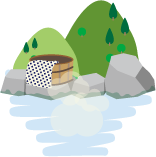
| Views of Mt.Onokoyama, Mt.Komochiyama, etc. |
| Public open-air baths for men and women |
| Point 4 |
|---|
Hot Spring Source Usage
| Water added No |
Heated No |
Disin fected No |
Circulated No |
Bath additive No |
|---|---|---|---|---|
| ○ | ○/× | ○ | ○ | ○ |
| *All bathtubs are 100% natural free-flowing hot spring water * Heating is applied except during the summer months. | ||||
| Percentage of hot spring source |
100% | ||||
|---|---|---|---|---|---|
| Replacement frequency of hot spring water | Once a day | ||||
| Spring Source Conditions | Water is drawn from the "Kogane-no-Yu" source (4,627 L/min), which is managed by the Komaguchi Rights Holders Association. The water is pumped using a motorized system (bored up from a depth of 400 meters). | ||||
| Distance from the source to the bathtub |
About 800m | ||||
| How hot spring water is drawn | From the spring located near the Ikaho Open-air Bath at the top of the stone-step street (Ishidan-gai), the water is directed down through wooden channels embedded below the street, utilizing the natural drop in elevation. | ||||
| How water temperature is adjusted | The flow of hot water into the bath is regulated, and the temperature is adjusted using a boiler. | ||||
| Drinking Spring | Cannot ※Non-submission of application for drinking to the health department | ||||
| "Gensen-Kakenagashi" Bath | Public bath for men and women x 2, Open-air Bath x 2, Guest room Open-air Bath x 2, Private bath x 4 | ||||
Hot Spring Composition TableHot Spring Analysis Report
| Spring Quality | Calcium, Sodium – Sulfate / Hydrogen carbonate / Chloride springs(Hypotonic, Neutral, Hot spring) Old springs name:Bicarbonate earth springs―Gypsum spring |
|---|---|
| Color of hot spring | Dark reddish-brown |
| Scent of hot spring | Scent of iron |
| Dissolved substances | 1,184mg/kg *About 8 times more components compared to bath additive! |
| Temperature of spring | 41.2℃ |
| pH | 6.4 (Neutral) |
| Yield | Approximately 400 to 800 liters per minute of hot spring water is drawn from the “Kogane-no-Yu”(Golden Hot Spring), the source of Ikaho Onsen, which has a total yield of 4,627 liters per minute. Per capita hot spring water usage (spring flow ÷ capacity): approximately 3.07 to 6.15 liters per person (maximum capacity: 130 people), the highest individual usage volume among Ikaho Onsen facilities. |
Hot Spring Composition (Amount contained in 1 kg of spring)
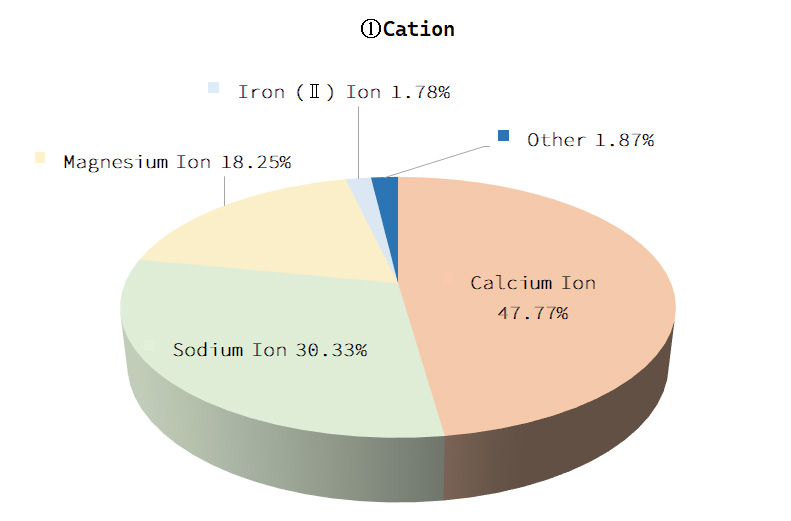 |
|||
|---|---|---|---|
| ①Cation | mg | mval | mval% |
| Calcium Ion (Ca2+)★ | 139.00 | 6.95 | 47.77 |
| Sodium Ion (Na+)★ | 101.00 | 4.41 | 30.33 |
| Magnesium Ion (Mg2+) | 32.20 | 2.65 | 18.25 |
| Iron(Ⅱ) Ion (Fe2+) | 7.23 | 0.26 | 1.78 |
| Potassium Ion (K+) | 8.70 | 0.22 | 1.53 |
| Manganese ion (Mn2+) | 1.39 | 0.05 | 0.34 |
| Aluminum ion (Al3+) | 0.050 | 0.00 | 0.00 |
| Cations Total(1) | 290.00 | 14.50 | 100.00 |
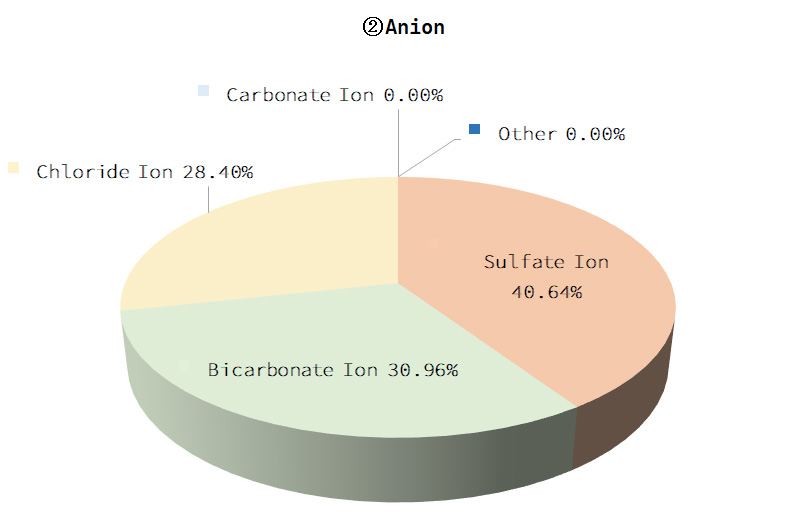 |
|||
|---|---|---|---|
| ②Anion | mg | mval | mval% |
| Sulfate Ion (SO42-)★ | 284.00 | 5.91 | 40.64 |
| Bicarbonate Ion (HCO3-)★ | 275.00 | 4.50 | 30.96 |
| Chloride Ion (Cl-)★ | 146.00 | 4.13 | 28.40 |
| Carbonate Ion (CO32-) | 0.10 | 0.00 | 0.00 |
| Fluoride Ion (F-) | 0.10 | 0.00 | 0.00 |
| Anion Total(2) | 705.00 | 14.50 | 100.00 |
| ③Undissociated Components | mg | mmol | |
|---|---|---|---|
| Metasilicic Acid (H2SiO3)★ | 181.00 | 2.31 | |
| Metaboric Acid (HBO2)★ | 8.30 | 0.19 | |
| Undissociated Components Total(3) | 189.00 | 2.50 | |
| Dissolved Gas Components | mg | mmol | |
|---|---|---|---|
| Free Carbon Dioxide (CO2) | 172.00 | 3.90 | |
| Free Hydrogen Sulfide (H2S) | 0.00 | 0.00 | |
| Dissolved Gas Components Total(4) | 172.00 | 3.90 | |
| Other Trace Components | |||
|---|---|---|---|
| Total arsenic 0.017 mg/ Total mercury, Lead ions, Copper ions not detected |
★are the ingredients related to the "spring quality" and the ingredients that qualify conditions for "hot spring" and "therapeutic hot spring".
Indications by Spring Quality for Bathing (Revised on July 1, 2014)
Cuts, Peripheral circulatory disturbance, Sensitivity to cold, Depression, Dry skin
General Indications for Bathing (Revised on July 1, 2014)
Chronic pain or stiffness of muscles or joints (chronic phase of rheumatoid arthritis, osteoarthritis, lower back pain, neuralgia, frozen shoulder, bruises, sprains, etc.),
muscle stiffness by motor paralysis, sensitivity to cold, peripheral circulatory disturbance,
gastrointestinal hypofunction (slow digestion, intestinal gas formation, etc.),
mild hypertension, impaired glucose tolerance (diabetes), mild hypercholesterolemia,
mild asthma or emphysema, pains of hemorrhoidals, autonomic instability,
various symptoms from stress (sleep disorders, depression, etc.),
restorative phase from illness, recovery from fatigue, health promotions
Contraindications by Spring Quality for Bathing (Revised on July 1, 2014)
None
General Contraindications for Bathing (Revised on July 1, 2014)
Active stage of diseases (especially when fever is accompanied), active tuberculosis,
advanced malignant tumor, or the case of significant debility involving severe anemia,
severe cardiac or lung diseases involving suffocation feelings with a little movement,
severe kidney disease involving edema, gastrointestinal bleeding,
when there is visible bleeding, acute exacerbation stage of chronic diseases, etc.
Indications by Spring Quality for Drinking
Not drinkable
Date of Analysis (The above hot spring composition table is cited from the survey data of the following institution)
May 30, 2017 (Gunma Pharmaceutical Association Environment and Health Testing Center)
- ※Indications and Contraindications for hot springs are in accordance with "Standard Methods of Analysis for Mineral Springs" revised on July 1, 2014.
- ※Data was provided by the ryokan.
20 qualifications for "hot spring" and 8 qualifications for "therapeutic hot spring"
| Conditions/Components (contained amount in 1kg) ※If even one of the conditions is cleared, it is a "hot spring" or "therapeutic hot spring" |
A【Hot Springs Act】 Conditions of the "hot spring" |
B【Standard Methods of Analysis for Mineral Springs】 Conditions of the "therapeutic hot spring" |
|
|---|---|---|---|
| 1 | Temperature (when collected from source) | 25℃ or more | |
| 2 | Dissolved substances (excluding gaseous) | Total amount 1,000mg or more | |
| 3 | Free carbon dioxide (CO2) | 250mg or more | 1000mg or more(Carbon dioxide springs) |
| 4 | Lithium Ion (Li+) | 1mg or more | ― |
| 5 | Strontium Ion (Sr2+) | 10mg or more | ― |
| 6 | Barium Ion (Ba2+) | 5mg or more | ― |
| 7 | Total Iron Ion[Fe2+(Iron(Ⅱ) Ferro ion)+Fe3+(Iron(Ⅲ) Ferri ion)] | 10mg or more | 20mg or more(Iron containing springs) |
| 8 | First Manganese Ion (Mn2+) | 10mg or more | ― |
| 9 | Hydrogen Ion (H+) | 1mg or more | 1mg or more (Acidic springs) |
| 10 | Bromine Ion (Br-) | 5mg or more | ― |
| 11 | Iodide Ion (I-) | 1mg or more | 10mg or more (Iodine containing Springs) |
| 12 | Fluoride Ion (F-) | 2mg or more | ― |
| 13 | Hydro Arsenate Ion (HAsO42-) | 1.3mg or more | ― |
| 14 | Meta Arsenite (HAsO2) | 1mg or more | ― |
| 15 | Total sulfur (S) [HS-(Hydrogen sulfide ion)+S2O32-(Thiosulfate Ion)+H2S(Free hydrogen sulfide)] | 1mg or more | 2mg or more (Sulfur Springs) |
| 16 | Metaboric acid (HBO2) | 5mg or more | ― |
| 17 | Metasilicic acid (H2SiO3) | 50mg or more | ― |
| 18 | Bicarbonate soda (NaHCO3) | 340mg or more | ― |
| 19 | Radon (Rn) | 20 or more (unit: ten ppb curie) 20×10-10or more Ci(curie) 20 or more (ten ppb curie) =74Bq(becquerel)/5.5 or more mache |
30 or more nanocurie(Radioactive springs) 30×10-10or more Ci(curie) 30 or more (ten ppb curie) =111Bq(becquerel)/8.25 or more mache |
| 20 | Radium salt (as Ra) | 10-8mg or more 1/100 million mg or more |
― |
| Number of conditions cleared this "hot spring" or "therapeutic hot spring" is: | 5 (Out of 20) | 2 (Out of 8) | |
| Total 7 Points | |||
Hot Spring Legends and More
Traditionally documented efficacies
-
Historical figures who bathed in this hot spring
-
Celebrities who bathed in this hot spring
Numerous cultural and celebrity visitors, not mentioned due to private uses
Hot Spring (Onsen) Report
In Gunma Prefecture, there are 3 excellent hot spring resorts known as the “Three Famous Hot Springs of Joshu” —Kusatsu, Ikaho, and Shima. Among them, Ikaho Onsen is especially well-known for its reddish-brown colored hot spring called “Kogane-no-Yu” (Golden Hot Spring).
Located nearly in the center of Gunma Prefecture, Ikaho Onsen is situated at an elevation of 700 to 800 meters on the northeastern slope of Mount Haruna. It is believed that the hot spring emerged as a result of the eruption of Mount Futatsudake in the 6th century. In the Manyoshu, Japan’s oldest anthology of poetry compiled between the late 7th and late 8th centuries, several poems mention the name Ikaho.
The source of Kogane-no-Yu can be found further beyond the top of the Ishidan-gai (Ikaho stone steps), in an area where the Ikaho Open-air Bath is located. The hot spring is drawn from wells drilled 100 to 400 meters underground, mixed, and flows at a rate of 4,627 liters per minute. The water is delivered through wooden channels beneath the stone steps to 9 inns that hold rights to use this water.
One of those inns is Chigira Jinsentei. Near the spring source outlet, you can see the stone wall of the “Site of the Original Chigira Residence”, a registered historical landmark in Shibukawa City, Gunma Prefecture. The Chigira family, a powerful clan, managed the spring, and it is believed that an inn existed near this location as early as 1502, which is considered the founding of Ikaho Onsen.
Long ago, hot springs served as a kind of medical treatment facility. After the defeat at the Battle of Nagashino in 1575, Takeda Katsuyori ordered Sanada Masayuki to develop the spring to heal his soldiers, which is how the famous stone steps came into being. Inns were built along the slope using the natural incline, with the source at the top. Other influential clans also settled in the area and opened inns along the steps.
Chigira Jinsentei, being the first inn of Ikaho and once the sole owner of the spring source, currently holds the most abundant rights among the 9 inns using Kogane-no-Yu. Every bath in the facility is filled with 100% natural free-flowing hot spring water, without any added water, circulation, or disinfection.
The color of the water is colorless and clear when it emerges, but it turns its mystical brown shade as the iron content oxidizes upon exposure to air. The famous brown-colored Japanese sweet, “onsen manju” (hot spring buns), often associated with hot spring resorts, derives its coloring from this spring.
Today, there are fewer than 50 hot spring inns in Ikaho, but only a limited number hold the rights to Kogane-no-Yu. Because of this, many inns have insufficient water supply and must receive water from inns that hold the rights. In 1996, Shibukawa City successfully drilled a new spring called “Shirogane-no-Yu” (Silver Spring). Unlike Kogane-no-Yu, it is colorless and does not meet the 25℃ requirement for named spring classification, though it is officially recognized under the Hot Spring Act due to its metasilicic acid content.
The spring quality of Kogane-no-Yu is classified as a “Calcium, SodiumSulfate / Hydrogen Carbonate / Chloride spring”. In short, it has the 3 characteristics of sulfate, hydrogen carbonate, and chloride springs. The pH value is 6.4, which is neutral and thus gentle on the skin, making it safe and comfortable for everyone from children to the elderly. There are many common indications for spring quality. The therapeutic benefits of the spring types—“sulfate springs”,“hydrogen carbonate springs”, and “chloride springs”—are largely shared. They are effective for cuts, peripheral circulatory disturbance, sensitivity to cold, and dry skin. The thermal effects of sulfate and chloride springs also influence the autonomic nervous system and are said to be effective for depression.
Among the dissolved substances, calcium ions (a cation) and sulfate ions (an anion) are the most abundant, forming a “Calcium
Sulfate Spring”. In the old classification, this was called a “gypsum spring”. Sulfate ions have healing effects on wounds and also stimulate skin elasticity, helping prevent wrinkles. Hence, this spring is known both as a “Hot springs for cuts” and an “Hot springs for anti-aging effect”. Calcium ions help form the skin’s keratin layer, making it famous as a “Hot springs for beautiful skin”. Moreover, due to its calming properties, it is also called a “Hot springs for strokes”.
The second most abundant anion is the hydrogen carbonate ion, which enhances blood circulation. When combined with calcium or magnesium ions, it forms a “Calcium (or Magnesium)
Hydrogen Carbonate spring”, previously classified as a “bicarbonate earth spring”. In the new classification, hydrogen carbonate springs include both the old “bicarbonate earth spring” and “sodium bicarbonate spring” (baking soda spring).
Calcium
Hydrogen Carbonate Springs (bicarbonate earth spring) often contain carbon dioxide and iron, and have a calming effect due to calcium and magnesium ions. They are also effective for chronic skin diseases and allergic dermatitis. Like sulfate springs, hydrogen carbonate springs are known as “Hot springs for beautiful skin”. Additionally, hydrogen carbonate springs promote perspiration after bathing, giving a refreshing post-bath sensation, which makes them popular even in the summer—hence the nickname “Hot springs for refreshing (with cooling effect)”.
The third major component, chloride ions (anions), helps retain body heat. The so-called “Sodium
Chloride spring” (formerly “salt spring”) prevents rapid cooling after a bath by blocking sweat glands with salt, hence called a “Hot springs for warmth”. Moreover, the coating effect of the salt in chloride springs contributes to their high moisturizing properties.
As evidenced by its diverse therapeutic benefits, Kogane-no-Yu is an exceptional hot spring. Moreover, it is 100% natural, flowing directly from the source without added water or circulation—truly a gift for the body.
Chigira Jinsentei uses approximately 400 to 800 liters per minute (depending on seasonal variations in output) from “Kogane-no-Yu”(total spring output: 4,670 L/min). Since the source temperature is 41.6℃, the water may cool slightly before reaching the baths, requiring heating during cooler months. This heating has minimal impact on the spring’s quality.
Also noteworthy are the sodium and hydrogen carbonate ions. According to the “Guidelines for the Mineral Spring Analysis Methods”, sodium-hydrogen carbonate (sodium bicarbonate) is considered a mineral salt. The guideline recommends multiplying the lesser of the two mval/kg values by the molecular weight (84.01) of sodium hydrogen carbonate. According to the spring analysis, sodium ions are 4.41 mval/kg. Thus, 4.41 × 84.01 = 370.48 mg/kg, exceeding the required 340 mg/kg for hot spring qualification.
Metasilicic acid, a natural moisturizing component, is also present at over 3 times the qualifying standard, contributing to soft, moisturized skin—another reason this spring is classified as a “Hot springs for beautiful skin”.
Furthermore, metaboric acid, known for acne prevention and cleansing, also exceeds the standard.
As a sub-specific feature, the spring contains 7.23 mg/kg of ferro ions (Fe2+), just below the 10 mg/kg requirement for official recognition but still beneficial. It promotes warmth, and may help with anemia, menopausal disorders, and menstrual issues. "Kogane-no-Yu" has long been referred to as a “Hot springs for fertility”," possibly due to these effects.
Another significant element is the 172 mg/kg of free carbon dioxide. While 250 mg/kg is required for hot spring status and 1,000 mg/kg for a recognized carbonated spring, this amount still exceeds most commercial bath additives, which contain only 40–100 mg/kg. However, due to the high temperature of the spring, bubbles are not visible.
Though the spring water has recognized benefits for drinking—such as for biliary dysfunction, hypercholesterolemia, constipation, gastroduodenal ulcers, reflux esophagitis, impaired glucose tolerance (diabetes), hyperuricemia (gout) and atrophic gastritis—the inn currently does not have public health approval for drinking use.
Despite having an abundance of hot spring water, Chigira Jinsentei has only 33 guest rooms with a maximum capacity of 130 guests. With 400 to 800 liters of hot spring water per minute, the inn could easily double its capacity while still maintaining 100% natural flow to all baths. However, the inn has deliberately chosen to remain at this scale. Could this be a reflection of its deep sense of responsibility as the founding ryokan of Ikaho Onsen?
Its sincere commitment to cherishing the hot spring—an invaluable gift from the earth—has supported its operation for over 500 years. The long-standing history is proof of this enduring devotion.
| Large public baths for men and women "Megumi-no-Yu" | Guest room open-air bath "Benimashiko" |
|---|---|
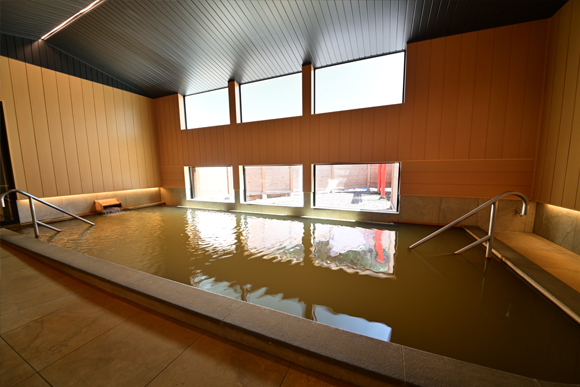 |
 |
| The symbolic large bathhouse of this inn. The baths are filled with "Kogane-no-Yu" (golden water) which is poured luxuriously free-flowing into the bathtub. It looks like an ordinary bathtub, but it is actually 1 meter deep. Regular customers call it a hot spring pool. The size of the bathtub is 5m x 3m, and walking is fine, but if you are lucky enough to use this bath alone, there is a very high probability that you will end up swimming in it. | Guest room open-air bath in the special annex "Tsuru-no-Ie". Taking advantage of the inn's location on the slope of the Ishidan Street, the guest room open-air baths offer a view of Mt.Onokoyama and Mt.Komochiyama. Of course, the hot spring water is 100% "Kogane-no-Yu" (golden water) free-flowing hot spring water. At night, the bath can be used as an indoor bath by closing the window. To be able to freely bathe in the famous hot spring at any time of the day is the ultimate in luxury. |
| Large public baths for men and women "Takiyu" | Private bath "Kokoro" |
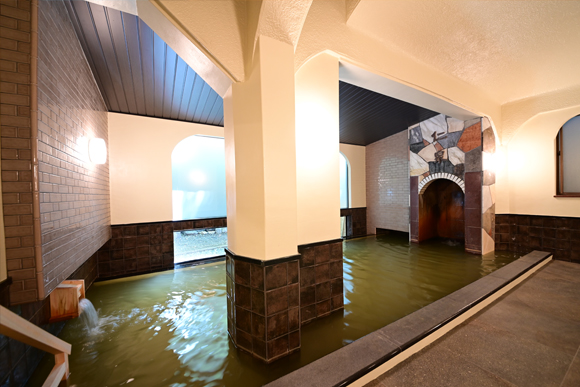 |
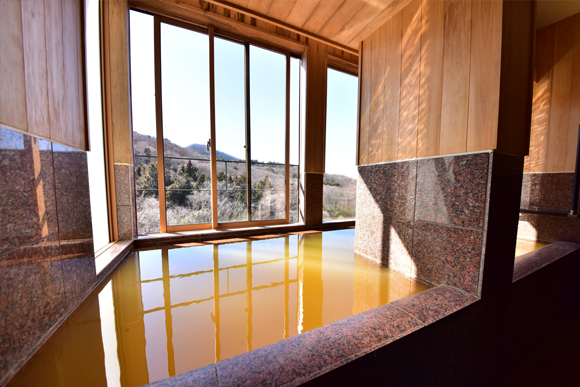 |
| The atmosphere has a retro feel that is completely different from "Ninoyu". As the name of the bath suggests, "Kogane-no-Yu" (golden water) falls into the bathtub like a waterfall. The "Takiyu" and "Ninoyu" are switched at 1:00 a.m. midnight between the men's and women's baths. If you stay overnight, be sure to soak in both baths. | Besides the public baths and open-air baths, the inn is also equipped with a private bath with free-flowing hot spring water, which can be used even late at night. The baths are free of charge. There are three other baths in addition to this one, and even when the inn is fully booked, it is possible to use them without waiting too long. |
Facility Report
Ikaho Onsen is one of the most popular hot spring areas in the Kanto region, located halfway up Mt. Haruna in Gunma Prefecture, and has a rich history and tradition from the Manyo Period (710-794). It is said that the hot spring water was discovered either 1,900 or 1,300 years ago. "Chigira Jinsentei", established over 500 years ago, is one of the oldest ryokan in the Ikaho Onsen area. The symbol of Ikaho is the 365-step Ishidan Street (stone stairway). When you climb to the top of the stone steps, near the Kawaga Bridge, you will find the source of the Ikaho Onsen "Kogane-no-Yu", and next to it, surrounded by stone walls, is the site of the "Chigira Motoyashiki". During the Tenbun era (1532-1555) of the Sengoku period, when Uesugi Norimasa, the nominal Kanto governor, was ruling the area, the Chigira clan was already in charge of the hot spring source. In the Edo period (1603-1867), the "Komaguchi Right Holders Association" was created to own the rights to the hot springs, which continues to this day, and the "Chigira Jinsentei" continued to be a central member of the association. The "Komaguchi Right Holders" (source owners) means those who own "Komaguchi", which is a hot spring piping system, and who each own a certain amount of hot spring water. Today, the 9 owners of the ryokan have formed an association to protect the centuries-old reddish brown "Kogane-no-Yu" (golden water) by stipulating strict rules for its use. Of these 9 ryokan, "Chigira Jinsentei" is said to have the largest amount of hot spring water per guest. Today, "Chigira Jinsentei" stands halfway up the stone staircase street and is also an inn connected to Tokutomi Roka (1868-1927), a great writer of the Meiji and Taisho eras. Roka loved Ikaho, especially this "Chigira Jinsentei" inn, and stayed here regularly, and even passed away here. His masterpiece, "Fujoki (The Cuckoo)" which is based on this inn was also set in this inn. Also, the poet Akiko Yosano and the great writer Junichiro Tanizaki are known to have visited the inn. Today, the inn is also known as the Imperial Family's official lodging. Despite its history and traditions, the inn is supported by a wide range of customers, with rooms available at reasonable rates, as well as rooms with the popular open-air bath. The inn has a large number of baths: large public baths for men and women + indoor baths, large public baths for men and women (Ninoyu and Takiyu), and 4 private baths that can be used free of charge. And the most wonderful thing about this inn is that the "Kogane-no-Yu" (golden water) is so abundant than other inns envy, and can be experienced as 100% natural free-flowing hot spring water. At present, there are around 50 onsen ryokan in Ikaho Onsen, but it is said that only about half of them use "Kogane-no-yu" (golden water). 9 of the right holders (source owners) must be splitting the hot spring with them. Note that "Chigira Jinsentei" does not share its hot spring water with any other ryokan. A regular customer told us that the hot springs here are "richer" than anywhere else. (Jin)
Travel Journal
Rates Data
| 1 night/2 meals fee | From 19,800 yen |
|---|---|
| 1 night/Breakfast fee | No settings |
| Stay without meals | No settings |
| Staying alone | No settings |
| Private bath fee when overnight stay |
Free |
| Day stay | No settings |
| Private bath for day-stay |
No settings |
Facility Data
| Establishment | 1502 (Muromachi period) |
|---|---|
| Check-In | 3:00 p.m. |
| Check-Out | 10:00 a.m.※"Tsuru-no-Ie", an annex of guest rooms with open-air baths, is at 11:00 a.m. |
| Location and Environment | The center of Onsen town |
| Number of Rooms | All 33 rooms (Main building: 3 rooms with half open-air bath, annex: 4 rooms with half open-air bath, 26 rooms with toilet) |
| Number of People Accommodated |
130 persons |
| Parking Area | Available for 100 cars |
| Facilities | Cafe, Bar, Esthetic salon, Table tennis, Private dining rooms, Karaoke, Shop |
| Internet | Wi-Fi available in all rooms |
| Barrier Free | Supported in some areas (wheelchair-accessible guest rooms, handrails on stairs and passageways, wheelchairs for free rental) |
| Toilet with washer | All rooms are equipped |
Transportation Access
| By train | From Ueno Station, 105 minutes by express train to Shibukawa Station, 30 minutes by bus / From Tokyo Station, take Shinkansen to Takasaki Station, 25 minutes by Joetsu Line to Shibukawa Station, 30 minutes by bus |
|---|---|
| By bus | Approx. 150 min. from Tokyo/Shinjuku Station by direct highway bus "Ikaho Onsen-go" or Kanetsu Expressway Highway Bus "Jyoshu Yumeguri-go". 7 min. walk from Ikaho Roka Kinenkan-mae stop. |
| By car | Kanetsu Expressway - Exit at Shibukawa/Ikaho IC, 20 min. |
| Address | Gunma / Ikaho Onsen / Chigira Jinsentei 45 Ikaho, Ikaho-machi, Shibukawa-shi, Gunma 377-0102, JAPAN. Phone:+81-(0)279-72-3355 |
- Data
- Aug. 19, 2024

